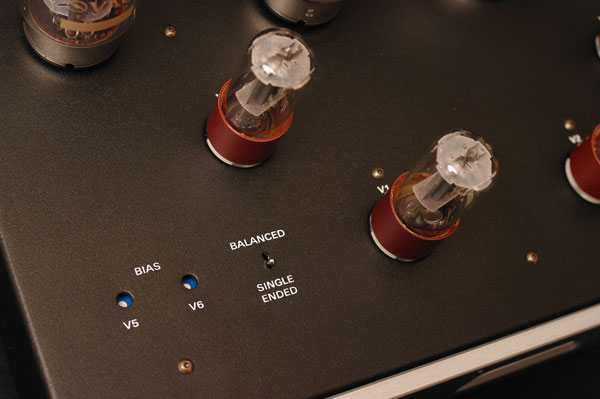Get a listening VACcination
Got the jitters, a bad case of Audiophilia Nervosa? Can’t seem to find that perfect sound? Nothing seems real enough sounding to you? Doctor Doug says get a shot of VAC equipment and you’ll start feeling better. I certainly feel better every time I use VAC gear in the systems I build. I do mean every time. If there has been one amplifier which has never failed me when reaching for top shelf sound, it is the Phi 200.
I already stated in the Signature Preamplifier MkII review that the preamp saves other brands of amps from poor performance; it literally preserves them from ignominy. I can say the same of the Phi 200. Of all the amplifiers my hands have touched thus far reviewing – you can check the list of my reviews – the Phi 200 is the amplifier I would keep. Following are the reasons, based on my listening impressions.
VAC equipment has an uncharacteristically big, beautiful sound. I first heard the Phi 200 with the King ESL. Am I glad I did, because there is a possibility that under show conditions hearing it with a different amp I may have dismissed it – a huge mistake. The King is extraordinarily good, and has sounded better with the Phi 200 than with any other amps I have used. I have used some good solid-state and hybrid amps with the king – Cambridge Audio Azur 840W amps in Bi-amp configuration, Pathos Classic One MkIII hybrids in Mono mode at 270wpc into 4 Ohms, a pair of Moscode 402Au, and the Einstein “The Light In The Dark”, as well as some others currently under review. I have had the Phi 200 on loan long enough to have compared it in more head-to-head listening tests with other amps than any other amp I have reviewed. I have heard the Phi 200 on about as many speaker systems as Kevin has for voicing. The conclusion is clear: the balance of power, fullness, and correctness is unparalleled. The King sounds good with one Phi 200, but is inspirational with two of them in Mono mode.
Recently a local dealer for VAC instruments came to my home twice to hear the King. The first time he heard it with solid-state amplification and thought it was nice. Prior to his return I told him, “Just wait until you hear the King with two Phi 200’s!” This time he brought his own discs, and this time he left with the phone number of Roger DuNaier at Performance Devices, because he had made up his mind he needed to carry the King as his ESL. It speaks well of an amp when a dealer is swayed to carry a line of speakers from hearing a system which has only had it inserted! The Phi 200 is that good. I know any time I am not hearing sound which is up to my ever escalating standards I can put the Phi 200’s in the rig and get that which I seek.
Rodrigo Y Gabriela
If you haven’t had opportunity to look up an incendiary guitar duo named Rodrigo Y Gabriela, I encourage you to do so. This fast paced, punch-packing acoustic guitar pairing has become a favorite for listening as well as conducting demos of equipment. I highly recommend their Live in Japan disc.
One track, named “FOC” – I’m almost afraid to know the meaning – has an extended percussion segment with the bodies of the guitars used to thump and pound out the driving rhythm. The clarity and depth of the Phi 200 is exemplary, allowing one to hear much further into the acoustic space of the venue than with the aforementioned amps. The Phi 200 seems to harbor more power than its specified rating. When the guitar is slapped one hears what I heard in the live performance, a powerful wallop, a percussive slam from the close microphone positioning, and a highly amplified signal all reverberating off the auditorium’s wall.
One does not hear from the VAC what most amps do to Rodrigo’s picking and plucking, a thinning out of the wiry notes. While initially such thinness is quite noticeable and seems captivating as “detail”, after a short while it becomes irritatingly brittle sounding. At first blush the VAC components may seem laid back, too reticent. But when listening to such intense playing and at higher levels for several minutes, much less a half hour, that more controlled expression of the string’s snap is very welcome as fatigue does not set in. In fact, fatigue never set in with these amps.
It reminds me of the lack of strain on the eye looking at a sunset versus summer midday sunlight. The sheer brightness of the sun causes one to squint, to filter out some photons crashing into the iris, but the late afternoon sky is much more forgiving. In the same way, some amps hand the music to your ear “bright and white”, strong and clear but in such a churlish manner that the ear wants to “squint”. Not so with the VAC, as you can put on truly harsh tunes and have the ear wrenching audacity of it ameliorated.
I have a couple of nastier test pieces for systems, ones which most systems even at shows fail miserably. One is Lenny Kravitz’s “American Woman”, and another is Apocalyptica’s “Enter the Sandman”. Kravitz plays with the vocals toward the end of the song, distorting his voice out of all proportion to decency. Even on good rigs he sounds so awful that I can usually not listen to the end; he comes across as a robot with a bullhorn singing. As for Apocalyptica, a truly hard driving band with three classically trained cellists and a drummer, I have not much good to say for the music; I just like getting a kick out of seeing if a system can handle it. The strings screech wretchedly, just the kind of effect needed to test the limits of a stereo’s top-end performance!
Watch out if you tee up either one of these to hit, because your system is likely to slice and send them sailing “out of bounds”. Only a handful of times have I avoided the cringe-factor when hearing these pieces and one of the only systems to handle them with any kind of aplomb was in my room with the Phi 200. The mollifying effect of the Phi 200 is to make these abominations sound like music. I can actually listen through to the end and pretend like I appreciate it. Anything less than fantastic amplification and these pieces get an automatic penalty; stop the music and move to the next artist.
Once I have the Signature Preamplifier MkII and Phi 200 dialed-in, I do not recall any piece I have terminated due to over-aggressiveness. On the other hand, I do recall replaying favorite pieces successively in an attempt to instill more of the mood, the aura, the loveliness of it. I usually want to move ahead, go on to the next experience, but I may repeat a performance when the Phi 200 is in the rig and feel it’s no waste of time.
More Stringent Criteria
Increasingly, as I age I am not interested in brightness, or “definition at all costs”. When I was younger I was willing to put up with such antics, but no longer. I have not capitulated on the demand for detail and definition. On the contrary, I demand them more than ever, but with the condition that they must be musically appropriate to the genre and recording. There are only two situations in use of power amps where I can say that both of these demands have been met to my satisfaction. One is with a trio of Coda CS amplifiers (under review) operating the Legacy Audio Whisper DSW in fully active crossover mode, a setup which gives a very unfair advantage to a solid-state amp.
The other is the more traditional loudspeaker of either the King Sound King or the Whisper DSW operating in passive crossover mode, powered by the pair of Phi 200 amps. That this setup can compete with a six-channel fully active crossover system is a testament to the authority and quality of the Phi 200. The best part is that the authority and quality is transferrable to any dynamic, full-range ESL or horn speaker system.
No kidding around
If you like upbeat vocals, you might want to check out Bobby McFerrin’s VOCAbuLarieS, in which he employs more than fifty singers weaving them into his energized African-inspired choral and solo works. The first track, “Baby”, is infectiously repetitive and upbeat as it brings to mind the runabout antics of a small child.
In comparison with the Einstein “The Light In The Dark”, the closest amp in quality to the VAC of those I have used, I found the Phi 200 to offer more heft in the bass singers’ voices, a touch more smoothness in blending all the singers and comparable clarity. When using the Ayon CD-5 as source with its internal preamplifier’s selectable gain setting at MID (6V), vocals sounded as if emanating from oversized heads. This effect was compounded when hearing it through the King, as ESLs tend to expand the center image anyway. With use of the 1-2 Ohm posts on the King and the GAIN of the CD-5 set to LOW (4V), the singers became more life sized and properly weighted. There is a terrific amount of flexibility offered by pairing higher-output sources like the CD-5 with the Phi 200, but you will want to watch out using output over 4V as it will likely begin to “inflate” the amp’s performance. Some people may adore that big-as-the-room sound, but others will want to rein it in.
The VAC sound is audio-writ large but properly proportioned; it is elegant, opulent and ebullient. The vastness and spatiality of the soundstage with the Phi 200 is quite surprising when heard for the first time. You may have heard many amps with differing power resources, and different levels of clarity. If you have worked primarily with solid-state amps, you likely have not heard the expansiveness a fine tube amp can bring to a system.
- ← Previous page
- (Page 4 of 5)
- Next page →



Hello, I enjoyed your review. I am in the middle of looking for and listening to amps. I am a bit scared by tubes but also drawn to their sound. I heard the VAC Sigma 160i SE and really liked it. My funds are limited but the question is whether I should save up a bit more and go with the Phi 200 and what pre-amp? Any thoughts. It will be paired with Wilson Sabrina speakers. May 7, 2016
Hi helen,i own sabrina as well ,paired with devialet200.
I would love to know your thoughts on vac amp?
Thks
Halló ég er með Yamaha ns 500 og Devialet 200 frábært sánd , er einnig með First Sound paramount mk 2 langar að spyrja virkar VAC phi 200 eða phi 300,1 við hann. kveðja jkþ ?
[English translation] Hello I have the Yamaha ns 500 and Devialet 200, also with First Sound paramount mk 2 would like to ask active VAC phi 200 or phi 300.1 to it. greeting jkþ?